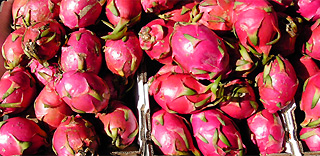Nowadays, many of New York's best greengrocers are found in Sunset Park, in a Brooklyn Chinatown that's less well known than those in Manhattan and Flushing, Queens. As my friends and I stepped off the N train at Eighth Avenue and 61st Street last weekend, we marveled at the vegetable stands, practically spilling their gleaming produce onto the sidewalks. Among the fresh longans, tiny strawberry bananas, and six-foot-long purple sugar canes sat boxes of bright pink dragon fruit with little green flaps coming off their sides like the fins on a '57 Chevy.

The price was $3.99 per pound, and we got two of them, each weighing about a half pound. When we got back to Williamsburg, we quickly halved one, then took spoons and scooped out the interior like custard, treating the rubbery skin like a bowl. The interior was pale, like lemon ice, and shot through with black dots. "Those look like poppy seeds," my friend Michelle exclaimed, scooping up a mouthful. The flesh was tart and gritty in an enjoyable way, tasting something like kiwi. We quickly finished the two halves and sliced into the other one. We briefly considered using it to invent a new cocktail, but the temptation to eat it on the spot was too great.
Also known as pitaya, dragon fruit is the pear of an epiphytic cactus species Hylocereus undatus. It was probably introduced into Vietnam a century ago by the French, who had a colony—now a département of France—called Guyane (French Guiana in English). How odd, we thought, spooning up the last of the second specimen, that this delicious South American fruit should return to this hemisphere via a Chinese immigrant community.

